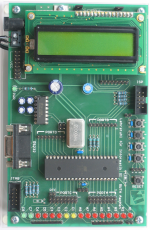Table of Contents
Hi Folks,
we're about to translate the german site. Maybe you want to use Google translator in the meantime. For further information do not hesitate to contact Dr.-Ing. André Stollenwerk.
ATmega evaluation board
In 2004 we began to develop a microcontroller-based evaluation baord for usage in education and research. This Baord was refined over the years.
Since our students every now and then showed interest in having such a board by themselves, we decided to publish the PCB layout and the partlists. Based on these files everybody has the chance to reuse our work to create an evaluation board suited to the particular needs or just copy the existing design.
Right now there are several extension modules to the main platform. Some of them are also available on this website.
|
The main platform is able to embed different models of the AVR ATmega. These are:
|
|
 |
Main Platform
The main platform works with a 8 bit microcontroller and supplys the microcontroller and the surrounding devices with voltage. The input voltage may be between 7 and 25 Volt. In addition the platform offers the following features:
- 2 x 16 CharacterLCD
- 4 Buttons
- 16 LEDs
- external crystal oscillator
- RS232 interface at 9 pin D-Sub connector
- ISP interface
- JTAG interface
- optional clock crystal for time measurement
- optional power supply via battery clip with 9 Volt block
- adjustable contrast of LCD
- configrable wiring of AD converter
- 2 x 8 pins each with Vcc and GND respectively
- reset button
Mikrocontroller
Like mentioned above the main platform can be used with different models of the ATmega microcontroller, since some of them are pin-compatible. This results in only software to be adapted but not hardware if the microcontroller was exchanged. The capacity of memories (flash, SRAM, EEPROM) doubles for each step.
The microcontroller chip itself is very inexpensive, but the programming hardware can be expensive. For instance the ATmega644 can only be programmed (if you want to use JTAG) by the JTAGICE mk II adapter, which costs about 300 Euro. This device is several hundreds euro more expensive than the smaller brother (JTAGICE). More on this topic in the latter.